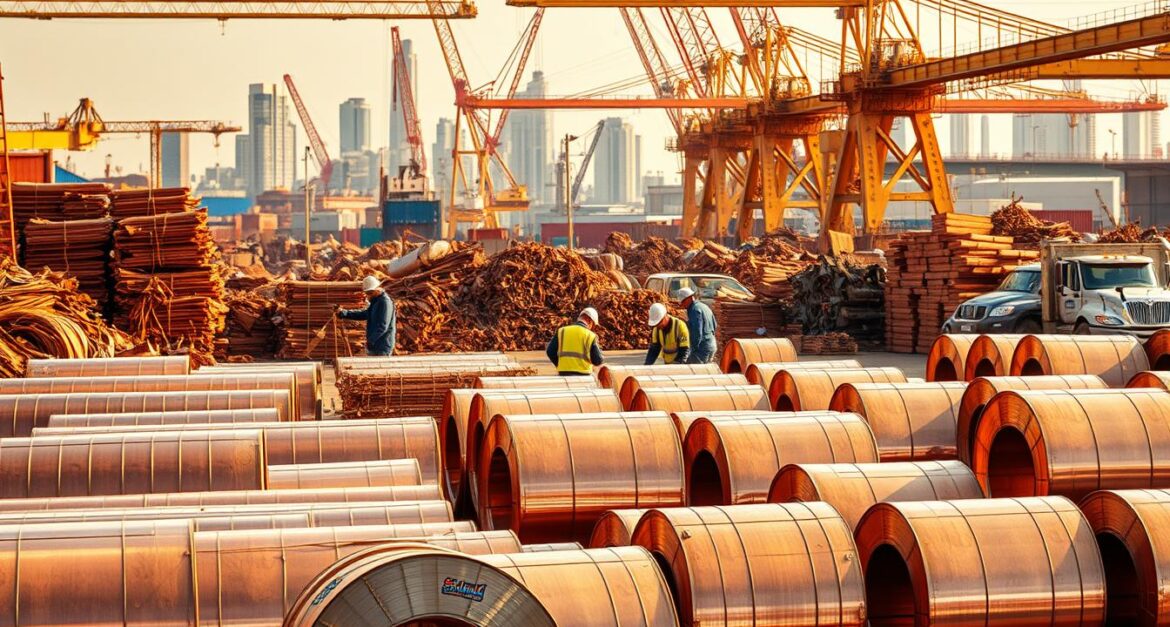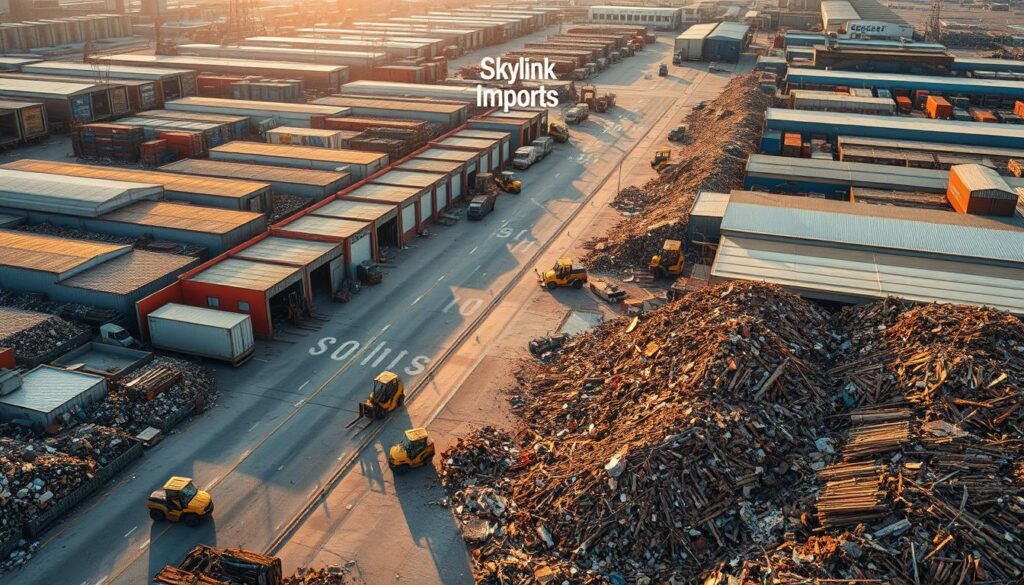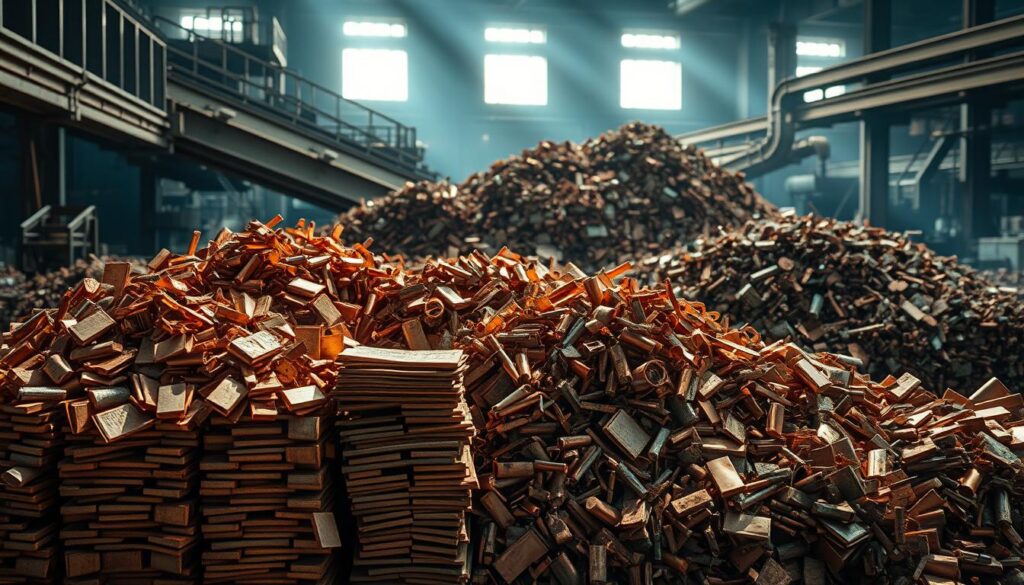
The world is witnessing an unprecedented surge in the demand for high-quality copper scrap, driven by the rapid expansion of industries and the global shift towards green energy initiatives. As a result, the copper scrap market is expected to experience significant growth in 2025, with sustainable copper recycling trends playing a crucial role.
As a leading import-export solutions provider, Skylink Imports is poised to capitalize on this trend, bridging the gap between manufacturers and markets with unmatched efficiency, reliability, and transparency. The increasing applications of copper scrap in manufacturing and renewable energy sectors are driving the copper scrap market analysis to new heights.
Key Takeaways
- The global demand for high-quality copper scrap is on the rise.
- Sustainable copper recycling trends are driving market growth.
- Skylink Imports is well-positioned to meet the growing demand.
- Copper scrap applications in manufacturing and renewable energy are increasing.
- The copper scrap market is expected to witness significant growth in 2025.
The Current State of the Global Copper Scrap Market
Driven by industrial growth and environmental concerns, the global copper scrap market is undergoing substantial changes. As a key player in sourcing and procurement, companies like Skylink Imports are navigating these shifts to meet the growing demand for high-quality copper scrap.
Market Size and Value in 2023-2024
The global copper scrap market has seen significant growth in 2023-2024, with its size and value increasing due to heightened demand from various industries. The market value has been bolstered by the rising need for sustainable materials and the expansion of industrial manufacturing. According to recent market analysis, the global copper consumption forecast indicates a continued upward trend, driven by the green energy sector and infrastructure development.

Key Market Drivers and Restraints
The copper scrap market is driven by several key factors, including the increasing demand for recycled copper in industrial applications and the growing emphasis on circular economy initiatives. However, the market faces restraints such as supply chain disruptions and quality control issues. Understanding these dynamics is crucial for stakeholders to effectively navigate the market and capitalize on emerging opportunities.
As the market demand for copper scrap continues to grow, driven by global copper consumption forecasts, companies must adapt to the changing landscape. This involves investing in advanced recycling technologies and developing robust supply chains to ensure a stable supply of high-quality copper scrap.
Understanding Copper Scrap Quality Classifications
Understanding the nuances of copper scrap quality is essential for suppliers and manufacturers aiming to meet the growing demand for high-quality recycled copper. Copper scrap quality classifications are crucial in determining the suitability of copper scrap for various applications, influencing both market dynamics and customer satisfaction.
International Grading Standards for Copper Scrap
Copper scrap is graded based on international standards that consider factors such as purity, contamination levels, and physical characteristics. The most widely recognized grading standards include those set by the London Metal Exchange (LME) and the Institute of Scrap Recycling Industries (ISRI). These standards provide a framework for evaluating copper scrap quality, ensuring consistency across the industry.
The grading process involves assessing the copper content, presence of impurities, and other physical attributes. For instance, high-quality copper scrap is expected to have minimal contamination and high copper content. The table below illustrates a simplified grading scale based on common international standards.
| Grade | Copper Content (%) | Contamination Level |
|---|---|---|
| Grade 1 | 99.9+ | Minimal |
| Grade 2 | 95-99.8 | Low |
| Grade 3 | 85-94.9 | Moderate |
What Constitutes “Best Quality” Copper Scrap
“Best quality” copper scrap is characterized by its high purity, minimal contamination, and adherence to international grading standards. Suppliers like Skylink Imports aim to provide high-quality copper scrap that meets these stringent criteria, ensuring it is suitable for demanding applications in industries such as electronics and renewable energy.

The demand for the best quality copper scrap is driven by its critical role in sustainable manufacturing and the circular economy. By understanding and adhering to international grading standards, suppliers can ensure that their copper scrap meets the required specifications, contributing to the overall sustainability of the copper industry.
Factors Driving Global Demand for Best Quality Copper Scrap in 2025
Several key factors are driving the global demand for the best quality copper scrap in 2025, transforming the industry landscape. As the world moves towards more sustainable and technologically advanced practices, the need for high-quality copper scrap is becoming increasingly critical.
Industrial Manufacturing Growth
The growth of industrial manufacturing is a significant driver of the demand for the best quality copper scrap. Copper is a crucial material in various manufacturing processes due to its excellent electrical conductivity, durability, and versatility. As industries expand, the need for a reliable and high-quality copper supply becomes more pressing.
Skylink Imports is committed to supporting sustainable practices by providing premium copper scrap to meet the growing demands of industrial manufacturing.
Green Energy Transition and Electrification
The global shift towards green energy and electrification is another major factor driving the demand for high-quality copper scrap. Copper plays a vital role in renewable energy technologies, including solar and wind power, as well as in electric vehicles. The increasing adoption of these technologies is creating a surge in demand for copper.
The green energy transition is expected to continue driving the demand for copper scrap in 2025 and beyond.
Circular Economy Initiatives
Circular economy initiatives are also boosting the demand for recycled copper. By promoting the reuse and recycling of materials, these initiatives help reduce waste and the environmental impact of industrial activities. The demand for high-quality copper scrap is rising as a result of these sustainability efforts.
| Driver | Description | Impact on Copper Demand |
|---|---|---|
| Industrial Manufacturing Growth | Expansion of manufacturing industries | Increased demand for copper in various applications |
| Green Energy Transition | Adoption of renewable energy technologies | Higher demand for copper in solar, wind, and electric vehicles |
| Circular Economy Initiatives | Promotion of recycling and reuse | Rising demand for high-quality copper scrap |
As these factors continue to influence the market, the global demand for the best quality copper scrap is expected to remain strong in 2025. Skylink Imports is poised to capitalize on these trends by providing premium copper scrap to meet the growing needs of various industries.
Regional Analysis: Key Markets for Premium Copper Scrap
The global demand for premium copper scrap is not uniform, with certain regions emerging as key players in the market. This variation is driven by factors such as industrial growth, environmental regulations, and the presence of recycling infrastructure.
United Arab Emirates: Emerging Hub for Copper Recycling
The United Arab Emirates is rapidly becoming a significant hub for copper recycling due to its strategic location and growing infrastructure. The country’s pro-business environment and state-of-the-art recycling facilities are attracting investments in the copper scrap sector.
The UAE’s emergence as a copper recycling hub is also driven by its proximity to major markets in Asia and Africa, making it an ideal location for regional trade. Companies like Skylink Imports, with operational roots in India and a global reach, can leverage the UAE’s growing copper recycling industry to expand their market presence.
Asian Markets: China, India, and Southeast Asia
Asian markets, particularly China, India, and Southeast Asia, are crucial for the copper scrap industry due to their large manufacturing bases and growing infrastructure projects. These countries are driving the demand for premium copper scrap, driven by their rapid industrialisation and urbanisation.
- China remains one of the largest consumers of copper scrap, driven by its massive manufacturing sector.
- India is emerging as a significant market for copper scrap, with its growing infrastructure and industrial projects.
- Southeast Asia is also witnessing a surge in demand for premium copper scrap, fueled by its expanding manufacturing and construction sectors.
Western Markets: North America and Europe
North America and Europe are also significant markets for premium copper scrap, driven by their focus on sustainability and green technologies. The presence of well-established recycling industries and stringent environmental regulations is are key factor driving the demand for high-quality copper scrap in these regions.
The circular economy initiatives in these regions are further boosting the demand for recycled copper, making them attractive markets for suppliers of premium copper scrap.
Technological Advancements in Copper Recycling
Innovations in recycling technology are enhancing the quality and efficiency of copper scrap processing. The copper recycling industry is witnessing significant transformations with the adoption of advanced technologies.
Skylink Imports is committed to adopting the latest technologies to improve its copper recycling processes. This commitment not only enhances the quality of the copper scrap but also increases the overall efficiency of the recycling operation.
Innovations in Sorting and Processing Technologies
Recent advancements in sorting and processing technologies have revolutionized the copper recycling industry. Advanced sorting technologies, such as sensor-based sorting and air separation, enable the precise segregation of copper scrap from other materials.
These technologies improve the purity of the copper scrap, making it more valuable and desirable for manufacturing purposes. Furthermore, advanced processing technologies, including mechanical processing and hydrometallurgical techniques, enhance the recovery rates of copper from scrap materials.
Digital Solutions for Quality Control and Traceability
Digital solutions are playing a crucial role in enhancing quality control and traceability in copper recycling. Blockchain technology is being utilized to create transparent and tamper-proof records of the copper scrap’s origin and processing history.
This not only ensures the quality of the copper scrap but also builds trust among stakeholders in the supply chain. Additionally, digital quality control systems enable real-time monitoring and inspection of copper scrap, further ensuring that the material meets the required standards.
Sustainability and Environmental Impact of Copper Recycling
As the world shifts towards more sustainable practices, the importance of copper recycling cannot be overstated. Copper recycling plays a vital role in reducing the environmental footprint associated with copper production. By reusing copper from scrap materials, we can significantly decrease the need for primary copper production, which is energy-intensive and has a substantial environmental impact.
Carbon Footprint Comparison: Recycled vs. Virgin Copper
The production of copper from recycled materials results in a significantly lower carbon footprint compared to producing virgin copper. Studies have shown that recycling copper can reduce energy consumption by up to 85% and greenhouse gas emissions by around 65%. This substantial reduction is due to the avoidance of energy-intensive processes such as mining, crushing, and smelting, which are required for virgin copper production.
By adopting copper recycling, industries can contribute to a more sustainable future while also benefiting from cost savings. Skylink Imports supports environmentally friendly practices by sourcing and supplying high-quality recycled copper, aligning with global sustainability trends.
Regulatory Frameworks Promoting Copper Recycling
Various regulatory frameworks around the world are promoting copper recycling by setting standards and incentives. For instance, the European Union’s Circular Economy Package encourages member states to increase recycling rates and improve waste management practices. Similarly, in the United States, initiatives such as the Resource Conservation Challenge aim to promote recycling and reduce waste.
These regulatory frameworks not only support the growth of the copper recycling industry but also ensure that recycling practices are carried out in an environmentally responsible manner. By complying with these regulations, companies like Skylink Imports can ensure that their copper recycling practices contribute to a more sustainable future.
Leading Suppliers and Procurement Strategies
As the demand for high-quality copper scrap continues to rise, identifying reliable suppliers and effective procurement strategies becomes increasingly crucial. The global market is witnessing a significant shift towards sustainable practices, and copper recycling plays a vital role in this transition.
Top Global Suppliers of High-Quality Copper Scrap
Several suppliers have established themselves as leaders in the global copper scrap market. Companies like Skylink Imports are recognized for their commitment to quality and reliability. These top copper scrap suppliers have developed robust networks and implemented stringent quality control measures to ensure a consistent supply of premium copper scrap.
Some of the key characteristics of top global suppliers include:
- Advanced sorting and processing technologies
- Strong logistics and distribution networks
- Adherence to international quality standards
- Commitment to sustainable and environmentally responsible practices
Best Practices for Sourcing Premium Copper Scrap
Effective procurement strategies are essential for sourcing high-quality copper scrap. Companies should focus on building strong relationships with reliable suppliers, implementing robust quality control measures, and staying informed about market trends.
Some best practices for sourcing premium copper scrap include:
- Conducting thorough supplier audits to ensure compliance with quality and environmental standards
- Implementing rigorous testing and inspection protocols to verify material quality
- Negotiating long-term supply agreements to ensure stability and consistency
“The key to successful procurement lies in understanding the market dynamics and building strong partnerships with suppliers.”
By adopting these best practices, companies can ensure a steady supply of high-quality copper scrap, supporting their manufacturing needs and sustainability goals.
Challenges and Opportunities in the Copper Scrap Industry
The copper scrap industry is at a crossroads, facing supply chain disruptions and other challenges while also discovering new business opportunities. As the global demand for high-quality copper scrap continues to grow, driven by industrial manufacturing and green energy initiatives, the industry must navigate these challenges to meet the increasing demand.
Supply Chain Disruptions and Mitigation Strategies
Supply chain disruptions pose a significant challenge to the copper scrap industry. These disruptions can be caused by various factors, including geopolitical tensions, logistical issues, and regulatory changes. To mitigate these risks, companies like Skylink Imports are adopting strategies such as:
- Diversifying supply sources to reduce dependence on any single market
- Implementing flexible logistics solutions to adapt to changing circumstances
- Investing in technology to improve supply chain visibility and management
By adopting these strategies, companies can minimize the impact of supply chain disruptions and ensure a stable supply of high-quality copper scrap.
Emerging Business Models in Copper Recycling
The copper recycling industry is witnessing the emergence of new business models that are transforming the way copper scrap is sourced, processed, and traded. Some of these emerging models include:
- Digital platforms for copper scrap trading, which enhance transparency and efficiency
- Recycling facilities that specialize in processing complex copper materials
- Collaborative initiatives between recyclers, manufacturers, and policymakers to promote circular economy practices
These emerging business models not only address current challenges but also create new opportunities for growth and innovation in the copper scrap industry.
Conclusion: The Future Landscape of Copper Scrap Recycling
The global demand for best-quality copper scrap is expected to surge in 2025, driven by industrial manufacturing growth, green energy transition, and circular economy initiatives. As the copper industry continues to evolve, companies like Skylink Imports are poised to play a significant role in shaping its future.
With technological advancements in copper recycling and sustainability initiatives gaining momentum, the future landscape of copper scrap recycling looks promising. Skylink Imports aims to be a leader in the copper scrap market, providing high-quality copper scrap and supporting the industry’s evolution.
The increasing global demand for the best quality copper scrap in 2025 and beyond will require industry players to adapt and innovate. As a key player, Skylink Imports will be at the forefront of meeting this demand, driving the future of the copper industry towards a more sustainable and efficient model.
As the industry continues to grow and evolve, it is clear that the future of copper scrap recycling is bright, with companies like Skylink Imports leading the way. With a focus on quality, sustainability, and innovation, the copper industry is set to meet the challenges of the future head-on.
Email us: info@skylinkimports.com
Contact us: +1 (403) 266-9394, +91-9041-543543





